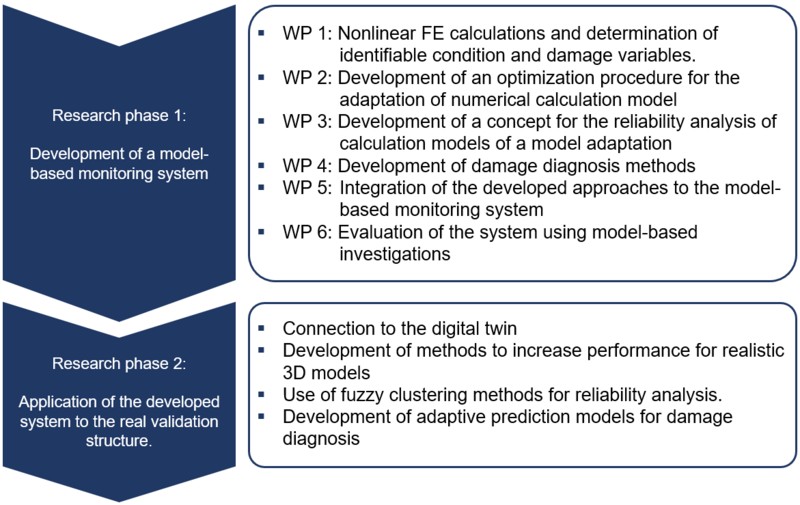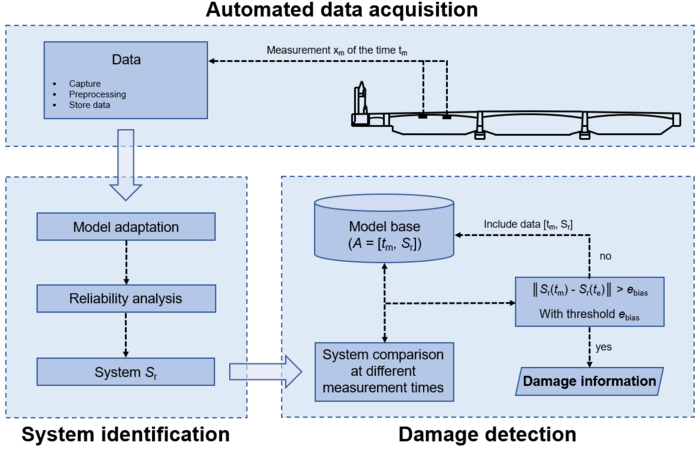Continuous monitoring of structures with model-based damage detection using nonlinear model fitting and artificial intelligence methods
The objective, proper assessment of the condition of structures and the early detection of the type, location and cause of damage represent the key aspects in structural health monitoring. Automated monitoring systems that continuously diagnose the behavior and condition of structures are becoming increasingly important. Non-destructive testing methods based on measurements and computational analysis are particularly useful in structural health monitoring. Currently, however, validated approaches to automated continuous monitoring of global structural health and detection of damage to massive structures face significant challenges.
The incorporation of automated monitoring systems enables objective and continuous recording of the structural condition. Thus, on the one hand, damages can be detected and evaluated promptly, and on the other hand, the aging process of the structure can be documented continuously. In the course of the priority project SPP 100+, the "Nibelungenbrücke" in Worms serves here as a validation structure for the development of an overall approach for the automated condition monitoring of highly stressed solid structures. The condition of the structure is to be described by reliably indicating the location and extent of any damage detected. The approach includes damage detection based on nonlinear model adaptation and artificial intelligence methods.
As part of the nonlinear FE calculations, sensitivity studies are performed to determine the identifiable condition and damage parameters, and the monitoring concept is prepared for the second phase of research. Due to the inverse problem of model adaptation, the uniqueness of solutions will be analyzed and evaluated. For the implementation, different methods of artificial intelligence are to be combined: The optimization task to be solved in the course of nonlinear model adaptation is highly complex.
The considered models can have a different number of degrees of freedom, different loads as well as several damage locations. Based on evolutionary algorithms, an optimization procedure is to be developed and used to find solutions in model adaptation. Since these optimization methods usually do not lead to a unique solution, clustering methods for the description of the obtained solutions will be investigated to increase the reliability. Here, a measurement point is assigned to a numerical computational model whose system component reliably describes the structural condition. Damage diagnosis is then performed by comparing the system states of different measurement time points. The concept of automated damage diagnosis developed in research phase 1 will be applied to the real validation structure in the second research phase.
Contact
Publication
Schnellenbach-Held, M., Karczewski, B.: Physical Nonlinear Model Identification in Model-Based Long-Term Structural Health Monitoring. Tagungsband ‘icccbe2010’, Nottingham, England, 2010.
Schnellenbach-Held, M., Karczewski, B.: Physics-Based Output-Only Model Identification of Reinforced Concrete Structures from Static Response. In: Proceedings of the 6th European Workshop on Structural Health Monitoring (EWSHM) 2012, Dresden, July 3-6, 2012.
Schnellenbach-Held, M., Karczewski, B., Kühn, O.: Intelligente Brücke – Machbarkeitsstudie für ein System zur Informationsbereitstellung und ganzheitlichen Bewertung in Echtzeit für Brückenbauwerke. Berichte der Bundesanstalt für Straßenwesen, Brücken- und Ingenieurbau Heft B 105, Bergisch Gladbach, 2014.
Schnellenbach-Held, M., Peeters, M., Miedzinski, G.: Intelligente Brücke – Schädigungsrelevante Einwirkungen und Schädigungspotentiale von Brückenbauwerken aus Beton. Berichte der Bundesanstalt für Straßenwesen, Brücken- und Ingenieurbau Heft B 110, Bergisch Gladbach, 2015.
Schnellenbach-Held, M., Peeters, M., Brylka, A., Fickler, S., Schmidt, I.: Überwachungskonzepte im Rahmen der tragfähigkeitsrelevanten Verstärkung von Brückenbauwerken aus Beton. Berichte der Bundesanstalt für Straßenwesen, Brücken- und Ingenieurbau Heft B 116, Bergisch Gladbach, 2015.






